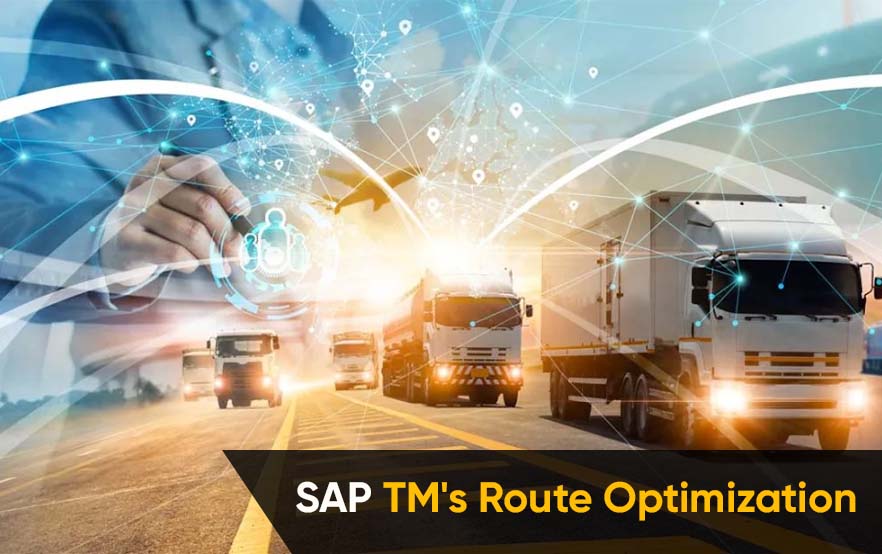
Introduction
Businesses compete in their various markets, attempting to keep logistics and transportation costs low while yet meeting the ever-rising expectations of their customers. Route optimization is a crucial aspect of transportation optimization since it helps companies make the best use of their resources, improve customer happiness, and cut costs.
What is Transportation Route Optimization?
The optimization of transportation routes involves solving complex mathematical problems related to the transportation network, specific constraints, costs, resources, and other factors. While there may not be a one-size-fits-all solution to this challenge, automation offers a more efficient approach compared to manual techniques.
Optimizer for SAP TM:
With the help of SAP TM’s innovative optimizer, firms can condense sales orders, maximize vehicle utilization, and create routes that satisfy customer delivery expectations. To produce the best results, the optimizer takes into account a number of factors, including geographical data, transportation infrastructure, delivery timetables, and resources. It can also manage unusual circumstances like compatibility issues with certain vehicles or the use of hazardous materials.
Features:
The SAP TM optimizer works to find the lowest transportation cost while considering factors like lateness or earliness. Optimal results can be achieved by configuring different optimizer runtimes. The four phases of the optimizer’s runtime behavior include creating models, gathering data, generating initial solutions, and improving results.
Strategies:
There are two strategies available in SAP TM: VSR_DEF and VSR_1STEP. While VSR_DEF is the default strategy used for optimization inputs, carrier selection optimization is disabled. In contrast, the VSR_1STEP strategy enables carrier selection optimization after running standard VSR. Both strategies use subsystems like TVSR and TVSS to optimize vehicle scheduling and routing.
Improving SAP TM Optimization Performance: Tips and Best Practices
Depending on how it is configured, SAP Transportation Management (TM) Optimizer’s optimization activities can take hours to complete. Businesses that must swiftly and effectively optimize resources may find this to be a significant difficulty. However, there are techniques to boost SAP TM performance and cut down on execution time.
Divide the Problem into Sub-Problems:
Dividing complex route optimization problems into smaller independent sub-problems can significantly enhance optimization performance. This approach can include dividing the problem by geography, product group, time horizon, or other relevant criteria. The subproblem approach reduces the total number of possibilities and minimizes memory consumption.
Reduce Means of Transport:
The number of available transport alternatives is a crucial aspect that influences how effective optimization is. Every kind of transportation creates additional choices, which slows down performance and consumes more memory. So limiting transit possibilities can have a big impact on how well optimization works.
Use Reference Coordinates and Zone Creation:
Locations that are close to one another can be identified using reference coordinates. Zones that contain many locations in the same area can be created to do this. Data and computation requirements can be reduced by centrally storing reference coordinates. To obtain precise coordinates, the integration of a geographic information system (GIS) will be required.
Manage Lanes Effectively:
Lanes describe the distance between locations in the transportation network. It is essential to maintain only the necessary lanes to obtain optimal results. Zone creation can be used to decrease data and calculations when there are multiple locations in the same area.
By strategically implementing zone creation and selectively maintaining essential lanes, transportation optimization algorithms can be more focused and effective. This approach not only enhances the overall performance of optimization processes but also contributes to better decision-making, reduced computational overhead, and ultimately, improved outcomes in the transportation domain.
Use Incompatibilities to Limit Complexities:
Incompatibilities are used to limit certain conditions or data from being input into the optimizer. This can help prevent the assignment of freight units to certain resources or to use transshipment locations. Each incompatibility applied reduces the number of resources, which increases optimization performance.
Conclusion:
SAP TM is an excellent solution for route optimization problems, but optimizing its performance can be challenging. Dividing the problem into sub-problems, reducing means of transport, incorporating reference coordinates and zone creation, managing lanes effectively, and using incompatibilities can all contribute to better performance and faster execution times. Consulting with a planning team can help identify the best optimization approach for a given use case.
Read more: What is SAP Transportation Resource Planning (TRP) and How Does it Work?


